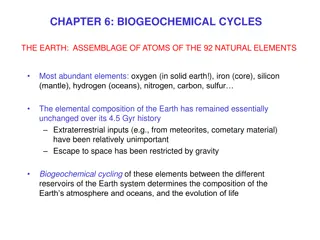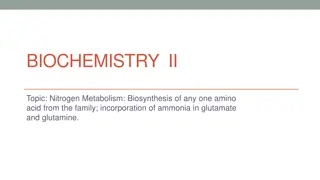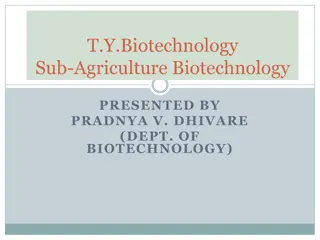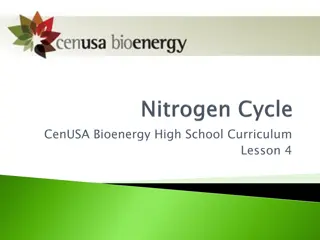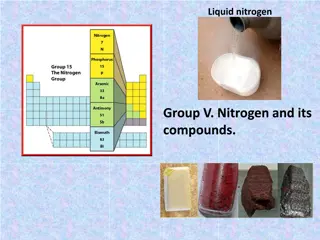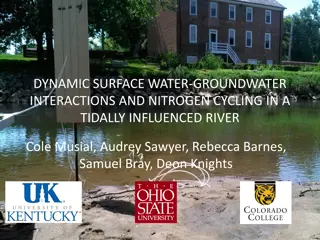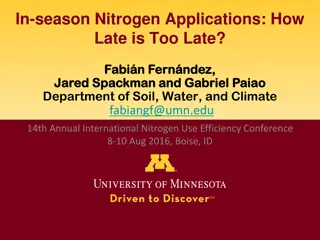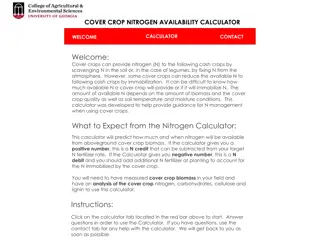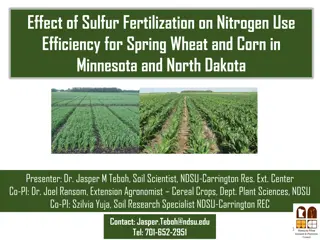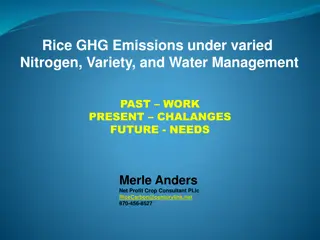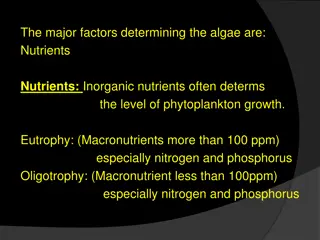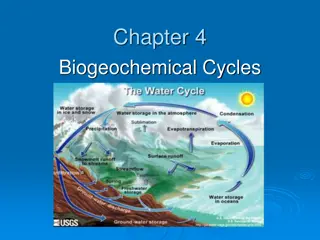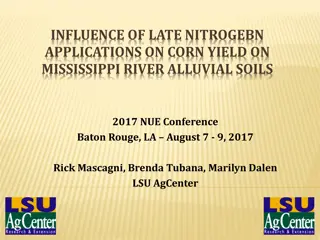Cycles of Water and Nitrogen
The essential processes of the water cycle, from evaporation to precipitation, along with the key components of the nitrogen cycle like fixation and utilization by living organisms. Dive into the interconnected systems that sustain life on Earth through these fundamental natural cycles.
Download Presentation

Please find below an Image/Link to download the presentation.
The content on the website is provided AS IS for your information and personal use only. It may not be sold, licensed, or shared on other websites without obtaining consent from the author.If you encounter any issues during the download, it is possible that the publisher has removed the file from their server.
You are allowed to download the files provided on this website for personal or commercial use, subject to the condition that they are used lawfully. All files are the property of their respective owners.
The content on the website is provided AS IS for your information and personal use only. It may not be sold, licensed, or shared on other websites without obtaining consent from the author.
E N D
Presentation Transcript
CHAPTER 2.2 Cycles of Matter
The Water Cycle 70% of the Earth s surface is water Oceans (97%) Rivers Lakes Underground reservoirs Atmosphere
The Water Cycle Evaporation The process during which liquid water changes into a gas called water vapor. 1. The Sun s energy 2. Temperature, wind, and humidity affect evaporation.
Condensation The process during which water vapor changes into liquid water. 1. Cooling of water vapor. 2. Clouds form due to condensation
Precipitation Water falls from clouds to Earth s surface. 1. Different forms: rain, snow, sleet, or hail
The Water Cycle - YouTube This video uses animation, graphics, and video clips to illustrate and explain each of the quot;flow ...
The Nitrogen Cycle Uses of Nitrogen(N2) 1. Essential part of proteins 2. An important part of DNA
1. Nitrogen gas is a form that plants and animals cannot use. Nitrogen Fixation The process that changes atmospheric nitrogen into nitrogen compounds that are usable by living things. bacteria - plants and decomposers
Nitrogen Cycle - Science - YouTube Nitrogen Cycle ,Nitrogen Fixation - Explanation in ... This is a science video about Nitrogen Cycle for Grade 9-10 students. visit http://www.makemegenius.com for Free Science videos for kids. Do you know that Plants ...
The Nitrogen Cycle | Chemistry for All | FuseSchool Nitrogen makes up 78% of the air, however neither plants nor animals can take nitrogen directly from the air because nitrogen is so unreactive. The nitrogen cycles shows the movement of nitrogen through the environment. Nitrogen is continually cycled through the air, soil and living things. Plants take up nitrogen compounds as nitrates from the soil. Animals then eat these plants, thus getting their nitrogen. The process of nitrogen in the atmosphere being turned into nitrogen in the soils is called fixing. There are different ways that nitrogen is 'fixed; including nitrogen fixing bacteria in the soil which turns nitrogen from the air into nitrates. Decomposers in the soils break down animal excretion and dead organisms, returning nitrogen back to the soil as ammonia. Lightning can cause chemical reactions in the atmosphere, resulting in nitrogen reacting with oxygen to produce nitrous oxide. Burning fossil fuels also adds nitrous oxide to the atmosphere, resulting in nitric acid, but this is of course not a natural way of nitrogen fixing. Blue-green algae in the ocean also can fix nitrogen. This then provides sources of nitrogen to aquatic animals, and the nitrogen goes around a similar cycle to what happens on land. The Haber Process makes up approximately 30% of nitrogen fixing. Denitrifying bacteria in the soil break down nitrates and return nitrogen back to the air. This reduces the fertility of the soil. SUBSCRIBE to the Fuse School YouTube channel for many more educational videos. Our teachers and animators come together to make fun easy-to-understand videos in Chemistry, Biology, Physics, Maths ICT. JOIN our platform at www.fuseschool.org This video is part of 'Chemistry for All' - a Chemistry Education project by our Charity Fuse Foundation - the organisation behind FuseSchool. These videos can be used in a flipped classroom model or as a revision aid. Find our other Chemistry videos here: https://www.youtube.com/playlist?list=PLW0gavSzhMlReKGMVfUt6YuNQsO0bqSMV Twitter: https://twitter.com/fuseSchool Access a deeper Learning Experience in the Fuse School platform and app: www.fuseschool.org Follow us: http://www.youtube.com/fuseschool Friend us: http://www.facebook.com/fuseschool This Open Educational Resource is free of charge, under a Creative Commons License: Attribution-NonCommercial CC BY-NC ( View License Deed: http://creativecommons.org/licenses/by-nc/4.0/ ). You are allowed to download the video for nonprofit, educational use. If you would like to modify the video, please contact us: info@fuseschool.org
The Oxygen Cycle Importance of Oxygen 1. Cellular respiration 2. Composition water carbon dioxide sugar
1. Oxygen in the atmosphere is the result of many years of photosynthesis. 2. Oxygen cycles through the ecosystem. Takes on different forms. Used to make other elements.
Oxygen Cycle Useful for CBSE, ICSE, NCERT International Students Grade 09 Subject: Biology Lesson : Natural Resources Topic: THE OXYGEN CYCLE Oxygen-cycle is referred to as the cycle that maintains the levels of oxygen in the atmosphere. Plants and other producers use carbon dioxide in photosynthesis. They produce oxygen as a waste product. Carbon dioxide moves from the air into the leaves of plants. Visit www.oztern.com to find personalized test preparation solutions for Pre Medical - AIPMT, AIIMS, JIPMER, State, Pre Engineering - IIT JEE, JEE MAIN, BITSAT, State and Foundations - Class 6 to 10.
The Carbon Cycle All organisms contain Carbon proteins sugars fats DNA All organisms get Carbon from food
Carbon in Soil Carbon enters the environment when organisms die and decompose. CO2gas Fossil Fuels
Carbon in Air CO2gas is released into the atmosphere During respiration.
The Carbon Cycle This professionally produced and narrated video describes the carbon cycle and why it is important, including an explanation of the Greenhouse Effect. It was produced for the Interactive Model of Leaf Decomposition (IMOLD) by the University of Toledo's Center for Creative Instruction in collaboration with Dr. Michael N. Weintraub and Dr. Daryl L. Moorhead, http://imold.utoledo.edu/
The Green House Effect CO2absorbs thermal energy from the Sun and keeps Earth warm. Greenhouse gases absorb thermal energy that reflects off Earth s surface. More gases, greater the gas layer and more thermal energy is absorbed
The Greenhouse Effect The temperature of earth has been relatively constant over time. This is possible because as the planet absorbs solar radiation, it also emits longwave radiation into space. Despite this radiative equilibrium, some longwave radiation remains trapped beneath the atmosphere of the earth and warms the surface of the earth. This phenomenon is called the "greenhouse effect." Read more about Global Warming here http://earthobservatory.nasa.gov/Features/GlobalWarming/?src=youtube




